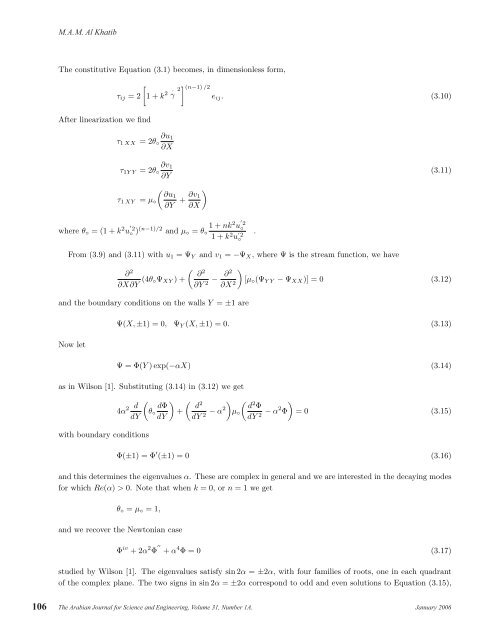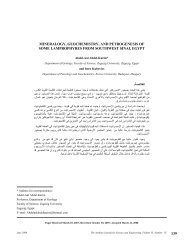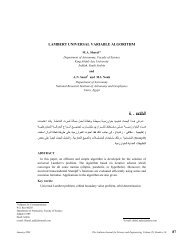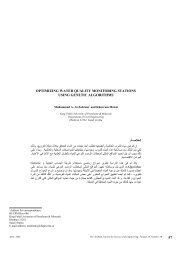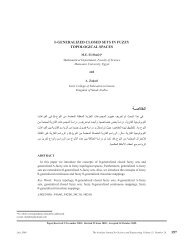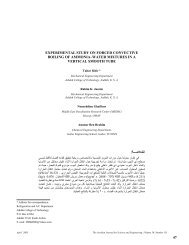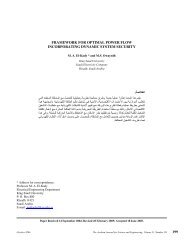the development of poiseuille flow of a pseudoplastic fluid
the development of poiseuille flow of a pseudoplastic fluid
the development of poiseuille flow of a pseudoplastic fluid
Create successful ePaper yourself
Turn your PDF publications into a flip-book with our unique Google optimized e-Paper software.
106<br />
M.A.M. Al Khatib<br />
The constitutive Equation (3.1) becomes, in dimensionless form,<br />
After linearization we find<br />
<br />
τij =2 1+k 2 · γ 2 (n−1) /2<br />
eij. (3.10)<br />
∂u1<br />
τ1 XX =2θ◦<br />
∂X<br />
∂v1<br />
τ1YY =2θ◦<br />
∂Y<br />
τ1 XY = µ◦<br />
∂u1<br />
∂Y<br />
<br />
∂v1<br />
+<br />
∂X<br />
where θ◦ =(1+k 2 u ′ 2<br />
◦ ) (n−1)/2 and µ◦ = θ◦<br />
1+nk 2 u ′ 2<br />
◦<br />
1+k 2 u ′ 2<br />
◦<br />
.<br />
(3.11)<br />
From (3.9) and (3.11) with u1 =ΨY and v1 = −ΨX, where Ψ is <strong>the</strong> stream function, we have<br />
∂2 ∂X∂Y (4θ◦ΨXY<br />
2 ∂ ∂2<br />
)+ −<br />
∂Y 2 ∂X2 <br />
[µ◦(ΨYY − ΨXX)] = 0 (3.12)<br />
and <strong>the</strong> boundary conditions on <strong>the</strong> walls Y = ±1 are<br />
Now let<br />
Ψ(X, ±1) = 0, ΨY (X, ±1) = 0. (3.13)<br />
Ψ=Φ(Y ) exp(−αX) (3.14)<br />
as in Wilson [1]. Substituting (3.14) in (3.12) we get<br />
<br />
2 d<br />
4α<br />
dY<br />
with boundary conditions<br />
θ◦<br />
2<br />
2 dΦ d d Φ<br />
+ − α2 µ◦<br />
dY dY 2 dY 2 − α2 <br />
Φ = 0 (3.15)<br />
Φ(±1) = Φ ′ (±1) = 0 (3.16)<br />
and this determines <strong>the</strong> eigenvalues α. These are complex in general and we are interested in <strong>the</strong> decaying modes<br />
for which Re(α) > 0. Note that when k =0,orn =1weget<br />
θ◦ = µ◦ =1,<br />
and we recover <strong>the</strong> Newtonian case<br />
Φ iv +2α 2 Φ ′′<br />
+ α 4 Φ = 0 (3.17)<br />
studied by Wilson [1]. The eigenvalues satisfy sin 2α = ±2α, with four families <strong>of</strong> roots, one in each quadrant<br />
<strong>of</strong> <strong>the</strong> complex plane. The two signs in sin 2α = ±2α correspond to odd and even solutions to Equation (3.15),<br />
The Arabian Journal for Science and Engineering, Volume 31, Number 1A. January 2006


